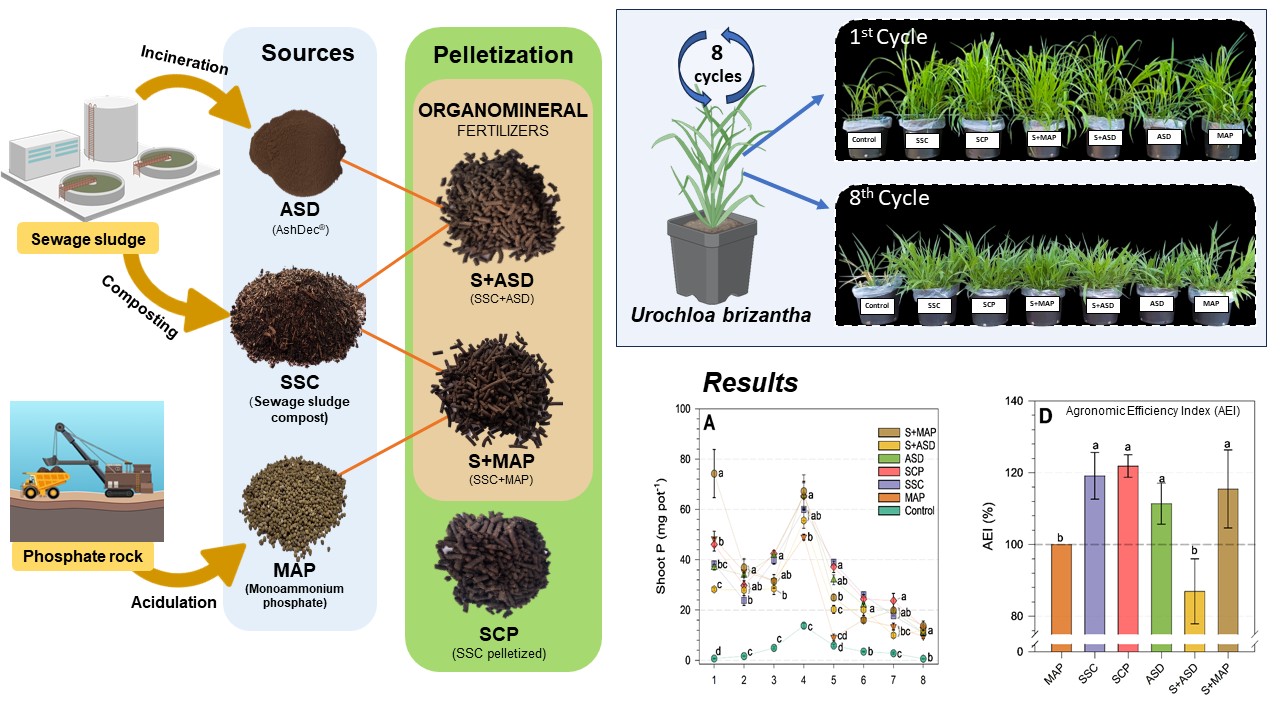Sewage sludge-based organomineral fertilizer improves phosphorus efficiency in Urochloa brizantha
17/Jun/2025
ABSTRACT Sewage sludge (SS) from wastewater treatment has reasonable phosphorus (P) levels, which could be used as fertilizer in agriculture. However, SS-P content is lower than mineral fertilizers, which limits its operational application. The blend of organic and mineral material can increase the P content, formulating organomineral fertilizers (OMF) with higher P levels, enabling agricultural use. This study aimed to assess the agronomic efficiency and residual effect of organomineral fertilizers derived from SS as phosphorus sources for Urochloa brizantha. A […]
Nitrogen mineralization after sewage sludge applications to four corn crops
01/Feb/2009
The available N in sewage sludge-amended soils is one of the restrictive factors for residue application in great amounts. This criterion must be considered in regulations for agricultural use of sewage sludge to avoid environmental pollution of soil and water bodies. The availability of mineral N from native soil organic-N is not considered in the calculation of the maximum rate of sewage sludge application, when these residues are applied for the first time, and this procedure is usual in the […]
Cadmium, chromium, lead and zinc in maize plants and oxisol after nine annual applications of sewage sludge
01/Oct/2008
A major limitation for using sewage sludge in agriculture is the risk of soil contamination with heavy metals and their possible transference to humans via food chain. The objective of this study was to evaluate the soil content of Cd, Cr, Pb, and Zn by two digestion methods (HNO3 + H2O2 + HCl and HClO4 + HF) in maize plants grown on a Typic Eutrorthox soil treated with sewage sludge for nine consecutive years, and the effects on dry matter […]
Sugarcane cultivation in a sewage-sludge treated ultisol. II – Soil fertility and plant nutrition
01/Apr/2008
The application of sludges, especially sewage-sludge (SS) to agricultural soils is one of the most rational ways of using this residue. The purpose of this study was to investigate the effect of SS on some chemical properties of an SS-amended Ultisol under sugarcane (variety RB 855536) for two years; from October 2002 to August 2003 – growing season 2003/04 and from October 2003 to October 04, designated 2004/05 crop season. Eight treatments were evaluated: (a) control; (b) Mineral fertilization (120 kg ha-1 […]
Sugarcane cultivation in a sewage-sludge treated ultisol. I – Soil nitrogen availability and plant yield
01/Apr/2008
Sewage sludge (SS) may be used as a nutrient source in agricultural soils, resulting in environmental and economical benefits, provided that specific technical criteria are applied. Unlike field conditions, residue application rates are estimated based on N mineralization trials under optimum temperature and humidity conditions. The objective of this study was to verify whether it is necessary an addition of mineral N (0, 60 and 120 kg ha-1 N) to sewage-sludge (14 and 16 t ha-1, dry weight) applied to sugarcane ratoon. Sugarcane (RB855536) […]
Organic carbon and nitrogen stocks, pH and bulk density of a Latosol after three sewage sludge applications
01/Jun/2007
The high organic matter content in sewage sludge is one of the reasons for its utilization as soil amendment. This study aimed to evaluate the effect of consecutive sewage sludge applications on the amounts of carbon, total and mineral nitrogen, pH, and bulk density in a Latossol. Two soil layers (0-0,1 and 0,2-0,4 m) were evaluated after three corn cultivations in Jaguariúna (São Paulo State, Brazil), between 1999 and 2001. The treatments consisted of three consecutive applications of two sewage […]
Effects of sewage sludge applications on heavy metal contents in corn leaves and grains
01/Jun/2006
Sewage sludge is an important source of nutrients for crops, although the heavy metal contents can limit its use in agricultural soils. The objective of this study was to evaluate the effects of doses of sewage sludge (from the Treatment Stations of Barueri (LB) and Franca (LF), São Paulo State, Brazil) on heavy metal concentration in corn leaves and grains. The experiment was carried out at the Experimental Area of the Embrapa Environment, in Jaguariúna, state of São Paulo, from […]
Soil chemical properties and eucalypt nutrition as a function of sewage sludge addition
01/Apr/2006
Sewage sludge application in forest plantations is one of the alternatives to solve the problematic final disposal of this residue. This research aimed at evaluating whether biosolids application improves soil fertility and the nutritional status of Eucalyptus grandis seedlings. The trial was installed in 20 cm diameter PVC columns with nine treatments (control, mineral fertilizer and increasing biosolid rates from 10 to 160 t ha-1) in four replications. The experiment lasted 12 months after planting the seedlings. Biosolids had a […]
Heavy metals availability for corn cultivated in a Latosol sucessively amended with sewage sludges
01/Apr/2006
This study carried out in order to evaluate the effect of sewage sludge (from Barueri: industrial and residential sewage, and Franca (SP) State: residential sewage) doses on soil heavy metal contents and their availability to corn. Three successive experiments were installed in a Latosol at the Experimental Field of Embrapa Environment, in Jaguariúna (SP), from 1999 to 2001. The treatments investigated consisted of: control (without sewage sludge); mineral fertilization (NPK) recommended for corn; and application of both sewage sludge sources […]
Zinc fractionation and availability by different extractants in sewage sludge-incubated soils
01/Dec/2005
The final disposal of sewage sludge has become a cause of environmental concern. Because of its high content of both organic matter and plant nutrients, sewage sludge has been used as fertilizer. However, it is important to know the fractions and bioavailability of heavy metals in sludge-amended soils. In the case of zinc, one of the most abundant metals in sewage sludge, knowledge on forms and plant availability are important to predict its behavior in soils. The present experiment was […]

